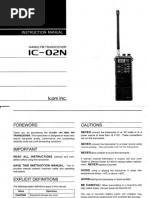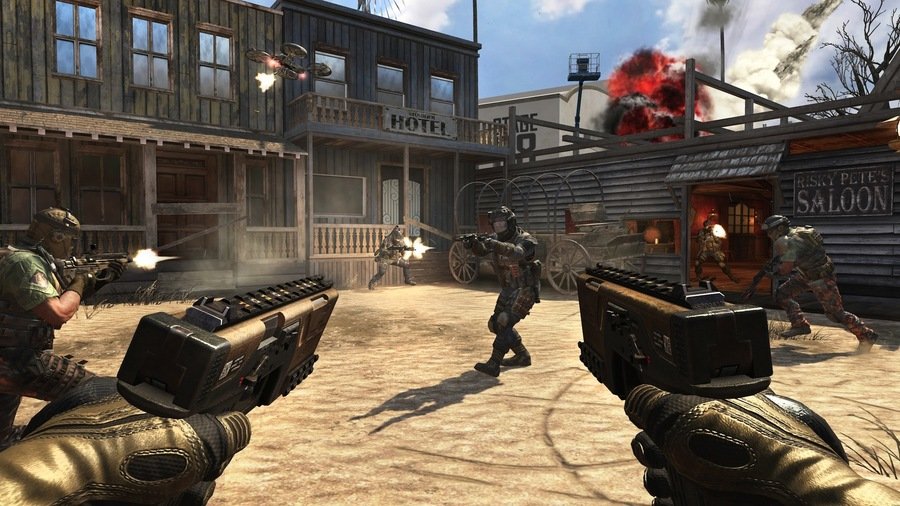Kenwood Th 75e Manual Dexterity
The TH-D74A is Kenwood's latest 5 watt 144/220/430 Mhz Tri-Band Digital handheld amateur radio that supports D-STAR and APRS. The TH-D74A transmits 144-148, 222-225 and 430-450 mHz.
- Kenwood Th 75e Manual Dexterity System
- Kenwood Th 75e Manual Dexterity 2
- Kenwood Th 75e Manual Dexterity Diagram
There are 4 power output settings of 5W, 2W, 0.5W and 0.05W. Battery life ranges from 6 to 15 hours depending on power output level and usage. The Kenwood TH-D74A features a color transflective TFT display that provides excellent visibility night or day. The D74A has built in GPS and Bluetooth along with a Micro USB and a microSD / SDHC slot.
The Kenwood TH-D74A meets IP54/55 standards, so you never have to worry about dusty outdoors or sudden rain showers. Wideband reception is possible on Band B. In addition to DV/DV Fast Data/FM/NFM/WFM/AM on 0.1 524MHZ bands, SSB/CW reception is also possible. The TH-D74A comes with a fine mode that achieves zeroing-in with a minimum step frequency of 20Hz on SSB, CW and AM modes and is equipped with a bar antenna (selectable with SMA antenna connector) for 0.1 10MHz reception. VxV, UxU, and VxU simultaneous receive functionality is also included.
Other features of the TH-D74A include 1,000 memory channels, 1,500 repeater lists, voice recording functionality, WEATHER ALERT/RX, voice guidance and much much more. In the box with the Kenwood TH-D74A you will find a screw on antenna, KNB-75L Li-Ion 1800mAh battery pack, Belt clip & Screw set, AC adapter/charger, instruction manual and warranty card.
The Kenwood TH-D74A has a 1 year warranty. Be sure to buy your Kenwood TH-D74A from GigaParts today!

The new, brilliantly evolved tribanderThis Tri-Band Amateur radio is packed with convenient features and the advantage of a digital transceiver with D-STAR, APRS support. Featuring a color transflective TFT display that offers excellent visibility in day or night. Plus, built-in GPS and Bluetooth support, as well as Micro USB and microSD/SDHC this radio is ready to harness the exciting developments in radio communicationsCompatible with the APRS communication protocol, which allows real-time two-way data transmission by using packet communications. This stand-alone device provides enjoyment of communications that make use of a variety of features, including sharing of local and GPS positional information and message exchange.Compatible with D-STAR, the amateur radio communications network that has both voice and data modes. Both local and international communications are possible through diverse operations including simplex communications, single repeater relay communications and inter-repeater gateway communications. Built-in high-performance GPS unit. Transflective color TFT display.
Weatherproof toughness meeting IP54/55 standards. Wide-band and multi-mode reception. Equipped with IF filter for comfortable reception (SSB/CW). High-performance DSP-based voice processing. Compliant with Bluetooth, microSD & Micro-USB.
The rest of the apps like Ps, Ai, iD.are fine.Everytime I tried to launch PP or AE, 'Premiere Pro could not find any capable video play modules' would pop-up. I'm guessing these are the only Adobe apps that require accelerated card. Adobe premiere pro video play modules in python free.

Review: Kenwood TS-2000 HF/VHF/UHF Amateur Radio Transceiver Untitled Document Kenwood TS-2000 HF/VHF/UHF TransceiverReview: Kenwood TS-2000 HF/VHF/UHF Amateur Radio Transceiver. High performance true IF/stage DSP on main band. AF stage DSP on sub-band. Digital filtering. (No more expensive options to buy).
Satellite ready, with transverter frequency display. Wide band receive. Dual receive, (HF & 2m or 70cm) (2m & 2m) (70cm & 70cm).
Cross band repeat. 100 watts output on HF, 6 and 2 meters. 50 watts output on 70cm, 10 watts output on 1.2 GHz (optional UT-20).
Built-in a Auto Tuner HF through 6 meters. Built-in TNC for KSS/DX PACKET CLUSTER TUNE. Built-in RS-232 for computer control. Built-in TCXO (.5PPM). CTCSS & DCS encode/decode. Electronic memory keyer. 5+1 Antenna ports.
(2 for HF & 6m, 1 for 2m, 1 for 70cm, 1 for 1.2 GHz option & 1 for and HF receive antenna). Remote operating capability with Kenwood's exclusive Sky Command system. Typical street price in USA-about $1,500I've now had the Kenwood TS-2000 for a year and I felt it was time to upgrade my earlier favorable review. The simple fact is, I'm still having the most fun I've ever had in 45 years of ham radio with this little odd-looking son of a gun!As I noted earlier, I still hear signals I can't reach with 100 watts and a darn good antenna.and couldn't imagine any rig that hears from the AM broadcast band to 70CM doing any better. No, it probably is not quite as sensitive as dedicated HF, VHF or UHF radios that cost scads more dinero. But this radio is most definitely NOT “deaf as a post,” as some other reviewers on eHam and other sites have charged.Also, I have seen no evidence of the radio getting hot to the touch as at least one reviewer reported. Admittedly I have not used it with long duty cycle modes such as PSK31 or RTTY, but I have done some AM and, though the fan cuts on and runs, the chassis does not become even slightly warm.
I've looked back at many of the reviews on eHam and I don't see any other mentions of such a phenomenon either, so I have to wonder if the lone reviewer who said it was a problem might have a defective unit or is misusing it in some way. Mine stays cool even when I operate for hours.One reviewer complained about having to use the menu to change key speed and CW tone. In fact, you don’t!
At least not to change keying speed. It's right there on a button called 'Key' just like several of the other things you do most often, each of which has its own dedicated button. Examples: like adjusting output power or microphone gain.

It is true that you do have to go to a menu (NOT a sub-menu, as has also been alleged) to adjust CW sidetone frequency, but how often does anyone really do that?The size of the buttons on the front panel could be a problem for some. I've got fat fingers and a neurological disorder that limits my manual dexterity but I've had no problem using the buttons. If you want bigger buttons, you have to have more menu items or a bigger face on the rig. Simple as that. You cannot have big buttons and no menu if you have as many features as the TS2000.Now, after a year of moderate use, here are a few quick thoughts on this remarkable “ham radio station in a box”:- Don't use the pre-amp on 160-20 unless you absolutely need it to try to pull a weak one out of the noise (which, by the way, will increase with the DX station you are straining to hear if you engage the pre-amp), or unless you live in an especially quiet environment. The bands will be much more pleasant to listen to if you shut it off.- I like to run the receive EQ wide open unless QRM is a problem.
Kenwood Th 75e Manual Dexterity System
It’s just a preference of mine. With a couple of cheap JBL speakers, decent SSB stations sound almost as good as FM. I love the audio-coming in and going out-on this box. And listening to stations who take pride in their transmitted audio is a real pleasure. I am an old broadcaster and I really do appreciate good, solid, pleasant-to-listen-to audio. By the way, I use the “Conventional” receiver EQ setting most of the time.- I got good unsolicited audio reports with the default microphone that shipped with the rig.
With a Goldline and the '5' element, and a little tweaking using Heil's suggested settings on the company’s, I get tons of (also unsolicited) comments on how good it sounds. It's getting downright embarrassing checking into the Alabama SSB net because whoever the NCS might be that night, he or she almost always compliments me. And with just a bit of compression, I have little trouble getting heard in pile-ups with guys running much more power.- The internal tuner is still a little fussy, but I am running a shortened G5RV (ZS6BKW version) which was never meant to be a 75-meter antenna (my MFJ 993B tuner won't make it work on the high end of 75 either, but it did get me on 30.and that may soon be my favorite band.next to 17, of course!). The internal tuner will get me better than 1.5 to 1 on the G5RV on 40, 20, 17, 12, and 10, does a good job of remembering where it's been, and always tunes in five seconds or less. Unless it can't manage the load and then the thing politely sends 'S' in Morse to let me know it is struggling.
Kenwood Th 75e Manual Dexterity 2
Hate to hear that! By the way, this is not a negative comment about the internal tuner. It does exactly what Kenwood says it will do.
Kenwood Th 75e Manual Dexterity Diagram
Anyone expecting it to match to a ten-penny nail is self-deluded!- I think the radio hears just fine, though I don't have anything else to compare it to. In our local 10-10 net on Tuesday nights, I usually hear the skip stations as soon as the local guys with big rigs and beams do, and can copy them just as well.
And anyone who complains about selectivity has probably not learned to use the DSP and other features.- I can't speak to the sensitivity on VHF/UHF. The local repeaters are full-scale on both the main and sub-receiver and I don't have an antenna for weak signal work.- Have not tried any of the digital modes either, but usually when someone on the TS-2000 Yahoo group is having some kind of problem, it turns out to be user error, they didn't read the manual, or they don't have the right cable.- More CW keyer memories would be nice.- It could scan just a little faster.Would I buy another one today? If I were going to put something in the car, I'd probably go to an Icom IC-706 or Yaesu FT-857 or similar.
They are smaller and have the detachable control head. But for the home station, and for the money they charge, yes, I would buy the TS2000 again.Not just yes, but YES!What a fun radio to own! I'm still amazed they don't charge twice as much for this thing. But let's not give Kenwood any ideas!October 2006.